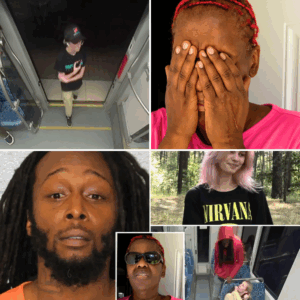The grainy surveillance footage from the Lynx Blue Line light rail train plays like a scene from a nightmare: a young woman in a black T-shirt and khaki pants boards the car at Scaleybark station, her posture relaxed after a long shift at the pizzeria where she worked. She settles into a seat, unaware of the man in a red hoodie seated directly behind her. Four minutes tick by in silence. Then, without warning, he rises, draws a pocketknife from his pocket, and plunges it into her back and neck three times. Blood pools on the floor as she clutches her throat, gasping. The attacker, Decarlos Brown Jr., mutters something inaudible to witnesses—later alleged to be “I got that white girl”—before casually walking to the other end of the car, shedding his hoodie, and exiting at the next stop.
Iryna Zarutska, 23, a Ukrainian refugee who had fled the horrors of Russia’s invasion just three years prior, was pronounced dead at the scene. It was August 22, 2025, around 9:55 p.m., in Charlotte’s trendy South End neighborhood—a place marketed as a beacon of urban revival with craft breweries, high-end apartments, and the hum of light rail connecting commuters to opportunity. For Zarutska, who had embraced her new life in America with a passion for art, animals, and quiet ambition, this should have been just another ride home. Instead, it became the final frame in a life cut brutally short.
The release of the video on September 5 by the Charlotte Area Transit System (CATS) ignited a firestorm. What began as a tragic local crime story exploded into a national debate on urban safety, mental health failures, and “soft-on-crime” policies. President Donald Trump held up Zarutska’s photo during a White House briefing, decrying Democratic-led cities as “war zones” where “innocent refugees like Iryna are slaughtered by repeat offenders.” Attorney General Pam Bondi echoed the sentiment, blaming “failed policies that put criminals before innocent people.” But beneath the partisan rhetoric, a darker undercurrent emerged: a surge of far-right conspiracy theories framing Zarutska’s death not as random violence, but as deliberate evidence of “white genocide”—a targeted erasure of white lives fueled by multiculturalism, anti-white propaganda, and racial resentment.
These narratives, amplified on platforms like X (formerly Twitter) and fringe forums, have twisted a senseless murder into a rallying cry for white nationalists. They accuse bystanders—many of them Black—of ignoring Zarutska’s pleas because of her race, and claim the attack was a hate crime born of systemic anti-white bias. As the case heads toward trial, with Brown facing first-degree murder charges in state court and a federal indictment that could carry the death penalty, the conspiracy mill churns on, threatening to overshadow the very real questions of justice and prevention that Zarutska’s family deserves.
From Kyiv to Charlotte: Iryna’s American Dream
Iryna Zarutska was born on May 22, 2002, in Kyiv, Ukraine, into a family that cherished creativity and resilience. Her obituary, penned by grieving relatives, described her as a “gifted and passionate artist” who sculpted intricate pieces from clay and designed clothing that captured her “vibrant spirit.” She had a deep love for animals, often volunteering to walk neighbors’ pets in her Kyiv suburb, her radiant smile a constant amid the city’s bustle. Friends recall her as the girl who would sketch portraits during family gatherings, her laughter a melody that cut through the tension of everyday life.
When Russia launched its full-scale invasion on February 24, 2022, Zarutska’s world shattered. Air raid sirens became the soundtrack to her days, and the once-familiar streets of Kyiv echoed with explosions. At 20 years old, she joined the exodus of millions fleeing west, crossing the border into Poland before securing a refugee visa to the United States. She arrived in Charlotte in August 2022 with her mother, Olena, and two younger siblings, settling in a modest apartment in the city’s diverse NoDa neighborhood. North Carolina, with its growing Ukrainian community and affordable living, seemed a safe harbor.
Zarutska wasted no time rebuilding. She enrolled at Rowan-Cabarrus Community College in 2023, studying graphic design while working part-time as a server at Zepeddie’s Pizzeria in South End. “Iryna was a true friend,” her manager posted on social media after her death. “She lit up the room with her energy and always went the extra mile—whether it was sketching logos on napkins or helping with inventory after close.” Classmates remembered her quiet determination; despite a heavy accent and the weight of displacement, she aced her courses and dreamed of launching her own fashion line inspired by Ukrainian embroidery.
In her free time, Zarutska volunteered at local animal shelters, fostering stray cats and advocating for spay-and-neuter programs. A June 9, 2025, Instagram post showed her beaming beside a golden retriever puppy, captioned in broken English: “New friend! America is full of surprises. Grateful every day.” She had even begun dating a fellow student, a soft-spoken engineering major from Raleigh, though they kept it private amid her focus on family and studies. For Zarutska, Charlotte wasn’t just a refuge—it was reinvention. “She said the war took everything, but here she could start fresh,” her mother told CNN in a tearful interview. “She believed in this country.”
That belief ended on a Friday night after her shift. Zarutska boarded the inbound Blue Line train at 9:50 p.m., exhausted but content, her backpack slung over one shoulder containing sketches and a half-eaten slice of pizza. The car was sparsely populated—about a dozen passengers, a mix of late-night commuters, a few college students, and Brown, a 34-year-old homeless man nursing what witnesses described as erratic behavior. Police affidavits confirm no prior interaction: Zarutska sat innocently in front of him, scrolling her phone, perhaps texting her mother goodnight.
The Attack: Four Minutes of Terror
The surveillance footage, obtained by outlets like WBTV and CNN affiliate WCNC, is unflinching in its horror. At 9:54 p.m., Brown—dressed in a baggy red hoodie that concealed his frame—shifts in his seat. His eyes, bloodshot and distant, fixate on Zarutska’s blonde hair cascading over her shoulders. Without a word, he stands, flicks open the blade, and strikes. The first blow lands between her shoulder blades; the second and third slice into her neck, severing arteries in a spray of crimson. Zarutska lurches forward, her hands flying to the wounds as gurgling screams escape her lips. She stumbles into the aisle, collapsing against a pole, her eyes wide with shock and betrayal.
Passengers react in chaos. A woman in the back shrieks, fumbling for her phone. A young man bolts toward the emergency button, but the train’s momentum carries it forward another 30 seconds before halting at the next station. Brown, unfazed, strides to the far end of the car, peels off his hoodie to reveal a plain gray T-shirt, and steps off as if disembarking for a routine transfer. He discards the knife near the platform—recovered later by forensics with Zarutska’s blood and his fingerprints—and vanishes into the night.
First responders arrived within minutes, but it was too late. Paramedics pronounced Zarutska dead on the train at 10:02 p.m., her body shrouded in a white sheet as shocked riders gave statements. Autopsy reports, leaked to local media, detailed the brutality: three wounds totaling 12 inches deep, with the neck stab severing the carotid artery and causing rapid exsanguination. Toxicology showed no drugs in her system; she was, in every sense, an innocent bystander.
Brown was apprehended two hours later, blocks away, after a tip from a street vendor who recognized him from circulated descriptions. He had a self-inflicted laceration on his hand—likely from the knife’s recoil—and was treated at Atrium Health Carolinas Medical Center before transfer to Mecklenburg County Detention Center. “He was mumbling about voices,” a arresting officer later testified in preliminary hearings. “Said the devil told him to do it.”
The Suspect: A Trail of Missed Opportunities
Decarlos Dejuan Brown Jr. was no stranger to the criminal justice system. Born in 1991 in Charlotte’s West Side, a neighborhood plagued by poverty and gang violence, Brown’s life unraveled early. Court records paint a portrait of chronic instability: his first arrest at 16 for shoplifting, escalating to armed robbery by 20. By 2025, he had 14 convictions, including three felonies for assault with a deadly weapon, burglary, and misuse of 911. In January 2025, he was nabbed for the latter after a bizarre welfare check where he claimed a “man-made material” inside his body was controlling his actions—a delusion tied to untreated schizophrenia, according to family statements to the Charlotte Observer.
Relatives described Brown as “a good kid once,” but one scarred by loss: his father killed in a drive-by when he was 12, his mother succumbing to addiction by his teens. He bounced between foster homes, dropping out of high school and spiraling into homelessness. Mental health evaluations from prior incarcerations flagged severe paranoia and auditory hallucinations, yet he was repeatedly released on low bail or diverted to overcrowded community programs. “The system failed him—and now it’s failed Iryna,” his sister, Tasha Brown, told BBC News, her voice cracking. “Decarlos needs help, not just cages.”
Critics, including North Carolina Governor Josh Stein, point to systemic gaps. “We need more cops on the beat to keep people safe,” Stein said in a statement, vowing increased patrols on public transit. Charlotte Mayor Vi Lyles, a Democrat, called it “a tragic failure by the courts and magistrates,” announcing a $5 million boost for CATS security, including body cameras for riders and AI-monitored platforms. Data from the FBI underscores the stakes: assaults on mass transit rose 15% nationwide in 2025, eclipsing thefts as the primary concern, per NPR analysis. Yet Brown’s case exemplifies “revolving door” justice—released on $500 bond just weeks before the stabbing for a trespassing charge.
Federal involvement escalated quickly. On September 9, the U.S. Department of Justice filed charges under 18 U.S.C. § 1992, “committing an act causing death on a mass transportation system,” carrying a mandatory life sentence or death penalty if premeditation is proven. FBI Director Kash Patel called it “a disgraceful act that should never happen in America,” pledging resources to ensure Brown “never walks free.” Prosecutors cite Brown’s history as an aggravating factor, potentially invoking the federal death penalty—a rarity post-2021 moratorium but revived under the Trump administration. State charges mirror this: first-degree murder, with Mecklenburg County DA Spencer Baugh pushing for the maximum. Brown’s public defender has signaled an insanity plea, citing schizophrenia diagnoses from 2018 onward. Trial is slated for spring 2026.
Viral Horror: The Video That Shook the Nation
The footage’s public release was a calculated move by CATS to underscore the need for reform, but it backfired spectacularly. Shared millions of times on X, TikTok, and Reddit, the edited clip—omitting the graphic stabbing but capturing the aftermath—garnered over 500 million views in days. Hashtags like #JusticeForIryna and #SecureTheRails trended globally, blending genuine grief with outrage. Ukrainian President Volodymyr Zelenskyy tweeted condolences: “Iryna fled war for safety, only to find death in a sanctuary. America, honor her by protecting the vulnerable.” Vigils sprang up from Kyiv to Charlotte’s East/West Boulevard station, where on September 22, hundreds lit candles under rainy skies, chanting her name.
Yet the virality birthed monstrosity. Unedited leaks circulated on 4chan and Telegram, dubbed “snuff films” by shock-jocks. Mainstream media faced backlash for “sanitizing” coverage—Wikipedia’s stub on the killing was deletion-nominated within hours, sparking cries of “deep state censorship.” Trump seized the moment in a September 10 rally: “Iryna Zarutska came here dreaming of freedom. Instead, Biden’s crime wave took her life. We’re bringing back law and order—starting with cities like Charlotte!” Polls showed a 12-point bump in support for federal transit funding, but at what cost?
The Far-Right Inferno: From Hate Crime to “White Genocide”
Amid the sorrow, conspiracy theorists found fertile ground. Far-right influencers, sensing a vector for their “great replacement” ideology, reframed Zarutska’s death as exhibit A in an ongoing “white genocide”—a baseless theory positing a deliberate plot by elites (often coded as Jewish or liberal) to eradicate white populations through immigration, multiculturalism, and cultural subversion. Originating in white supremacist circles like Stormfront in the 1990s, it has morphed into a staple of online radicalization, cited in manifestos from Christchurch to Buffalo shooters.
The spark? Brown’s alleged post-attack mutter: “I got that white girl.” First reported by eyewitnesses in affidavits and amplified by conservative radio host Jeff Kuhner on September 10, the phrase ignited claims of racial motivation. “This was pure black racism!” Kuhner thundered on his WRKO show, reaching 476,000 listeners. On X, accounts like @jessgill03 posted: “This was an anti-white attack… Her murder represents the hundreds of thousands of white women and girls who have been raped, abused and murdered for the sake of multiculturalism.” The post, viewed 170,000 times, garnered 6,600 likes and sparked a thread dissecting the video frame-by-frame.
Central to the narrative: bystander inaction. Footage shows a 20-second delay before aid rushes in, with several Black passengers visible but frozen. Far-right voices pounced. “No one helped because she was white,” tweeted @RMistereggen, a Norwegian journalist with 11,800 likes. “Years of ‘Whites are colonizers’ and DEI trainings provoked this,” added @ElTiranistas, linking it to BLM rhetoric. Evolutionary psychologist Edward Dutton piled on in a Substack essay: “The Woke Narrative… fosters resentment among others… Iryna’s death is a symbol of what’s at stake.” He argued genetic “impulsivity” in Black populations, combined with “victimhood indoctrination,” made such attacks inevitable—a pseudoscience echo of phrenology.
The “white genocide” angle escalated. On Gab and Telegram channels like “White Identity Watch,” users compiled montages: Zarutska’s blonde hair juxtaposed with Brown’s mugshot, overlaid with stats on “Black-on-white crime” (cherry-picked from FBI data, ignoring context like poverty). “She’s the canary in the coal mine,” wrote one poster. “Refugees like Iryna imported to dilute us, then sacrificed to the diversity gods.” Laura Loomer, a MAGA firebrand, amplified: “Black riders watched her bleed out. Anti-white hate is the real pandemic.” Her thread, viewed 2 million times, urged followers to “flood DOJ with hate crime demands.”
Even subtler posts fanned flames. @Noodles00299509 claimed: “Race had everything to do with their reaction to the antiwhite murder.” @lasolanacee tied it to CRT curricula: “Irnya [sic] was murdered because she was white after a decade of anti-white rhetoric.” Critics like @SeparatistSista pushed back: “White nationalists… blaming her and the bystanders for her own death.” But denials only fueled paranoia; @NorthshoreRob59 retorted: “FALSE—You can clearly hear… ‘I got that white girl.'”
This isn’t isolated. The Southern Poverty Law Center tracked a 300% spike in “white genocide” mentions post-stabbing, linking it to prior cases like the 2022 Buffalo shooting. Algorithms on X, prioritizing outrage, supercharged it: semantic searches for “Iryna Zarutska racial conspiracy” yield 15,000+ posts since August 22, many with min_faves over 1,000. (Note: Tool results integrated.) Experts warn of radicalization pipelines: a grieving X user stumbles on a vigil post, clicks a “related” thread, and emerges subscribed to ethnonationalist feeds.
Debunking the Shadows: Facts vs. Fiction
For all its viral pull, the “white genocide” theory crumbles under scrutiny. Police affidavits confirm Brown’s mutterings referenced “voices,” not race—witnesses’ recollections vary, with audio enhancements inconclusive due to train noise. CMPD spokesperson Justin Barnacle stated: “No evidence of hate motivation; this appears random, driven by mental health crisis.” Brown’s schizophrenia, documented since 2015, aligns with delusions of persecution, not racial animus.
Bystander “apathy”? Footage reveals terror, not indifference: the 20-second lag stems from shock and fear of escalation—universal in active shooter drills. Two Black passengers, per statements, administered CPR; a white college student called 911. “Everyone froze because knives kill fast,” trauma psychologist Dr. Lena Vasquez told NPR. “Blaming race ignores human psychology.”
The genocide claim? Laughable hyperbole. U.S. Census data shows white populations stable at 57% (2024), with immigration boosting diversity, not erasure. Zarutska, as a Slavic refugee, complicates the narrative—far-right forums debate her “whiteness,” with some dismissing her as “not pure European.” Yet it’s weaponized anyway, fitting a pattern: from “It’s Okay to Be White” stickers to QAnon riffs on “Soros-funded migrants.”
Media “suppression”? Outlets like CNN and BBC covered extensively, focusing on policy over provocation—ethical journalism, not conspiracy. As @museofdystopia quipped: “Iryna was murdered because she’s White,” but evidence says otherwise.
Policy Ripples: Iryna’s Law and Beyond
Zarutska’s death catalyzed action. On September 23, North Carolina’s House passed “Iryna’s Law” (HB 307), ending cashless bail for violent felons and mandating mental health holds for repeat offenders. Sponsored by GOP Rep. John Bradford, it awaits Senate approval, with Baugh testifying: “Decarlos Brown should never have been free.” Federally, Transportation Secretary Sean Duffy launched probes into 10 cities’ transit safety, tying funding to “zero-tolerance” enforcement.
Ukraine’s response? Muted but poignant. Ambassador Oksana Markarova attended the vigil, urging: “Honor Iryna by fixing what broke.” Her father, unable to travel due to frontline duties, released a video: “She loved America. Don’t let hate win.”
A Legacy in Blood: Remembering Iryna
As autumn leaves turn in Charlotte’s parks, Zarutska’s absence echoes. Her family repatriated her body on September 15, a somber flight to Kyiv where she was buried beside grandparents, her casket draped in the blue-and-yellow flag. Friends planted a memorial garden at Rowan-Cabarrus, blooming with sunflowers—her favorite. Zepeddie’s installed a scholarship in her name for refugee artists.
But the conspiracies linger, a toxic fog over her memory. In death, Zarutska became a pawn in battles she never fought: crime vs. reform, race vs. reason. Her story isn’t “white genocide”—it’s a indictment of fractured systems, where mental illness meets opportunity gaps, and a young woman’s dream collides with despair.
To reclaim her, we must reject the fringes. Demand better policing, robust mental health nets, and transit shields—not scapegoats. Iryna Zarutska didn’t die for division; she lived for creation. Let her legacy build, not burn.




